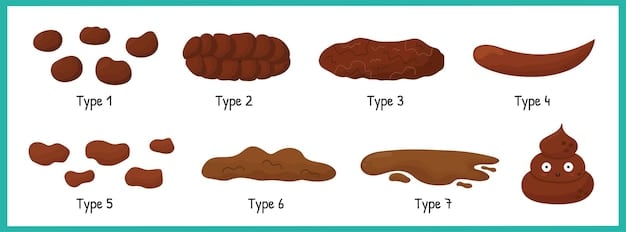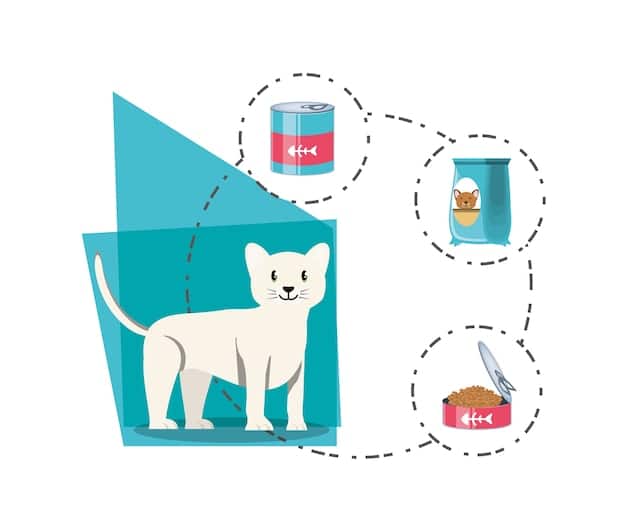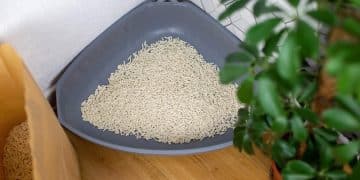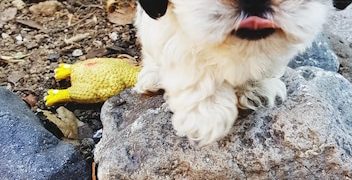Decoding Your Dog’s Poop: A Guide to Pet Health

Decoding Your Dog’s Poop: A Visual Guide to Identifying Potential Health Problems provides pet owners with essential knowledge to interpret their dog’s stool, helping to detect early signs of illness and ensure timely veterinary care.
Understanding your dog’s health can sometimes feel like a guessing game, but one of the most reliable indicators is often overlooked: their poop. Decoding Your Dog’s Poop: A Visual Guide to Identifying Potential Health Problems is crucial for any responsible pet owner.
Why You Should Pay Attention to Your Dog’s Poop
Paying attention to your dog’s poop might seem like a trivial or unpleasant task, but it’s actually a vital part of responsible pet ownership. Your dog’s stool can offer valuable clues about their overall health, diet, and potential underlying issues. Ignoring these signs could lead to delayed diagnosis and treatment of serious conditions.
Regularly monitoring your dog’s poop can help you:
- Detect dietary imbalances or allergies.
- Identify early signs of parasitic infections.
- Recognize gastrointestinal problems before they become severe.
- Assess the effectiveness of your dog’s current diet.
By becoming familiar with what is normal for your dog, you can quickly spot any deviations and take appropriate action, ensuring a healthier and happier life for your furry friend.
The Ideal Dog Poop: What to Look For
Knowing what constitutes ideal dog poop is the first step in identifying potential health problems. The perfect stool should have a specific color, consistency, shape, and content. Understanding these characteristics will allow you to quickly recognize when something is amiss.
Here’s a breakdown of the key indicators of healthy dog poop:
Color
The ideal color should be chocolate brown. This indicates that the digestive system is functioning correctly and that bile is being produced and processed normally.
Consistency
The consistency should be firm but not hard, similar to modeling clay. It should be easy to pick up without leaving residue on the ground.
Shape
The shape should be log-like, maintaining its form when picked up. This indicates good intestinal health and proper hydration.
Content
The stool should be free of visible parasites, excessive mucus, or undigested food particles. Occasional small amounts of grass are normal, but large quantities can indicate dietary issues or digestive upset.

By knowing these characteristics, you can regularly monitor your dog’s stool and quickly identify any concerning changes that warrant further investigation.
Decoding the Color Chart: What Different Hues Mean
The color of your dog’s poop can provide valuable insights into their health. Deviations from the ideal chocolate brown can indicate a range of issues, from dietary imbalances to more serious medical conditions. Understanding what different hues signify can help you take prompt and appropriate action.
Here is a color chart of dog poop and what they means:
- Black: This can indicate bleeding in the upper gastrointestinal tract, potentially from ulcers or other serious conditions. It requires immediate veterinary attention.
- Red Streaks: Red streaks in the stool suggest bleeding in the lower gastrointestinal tract, possibly from colitis, anal gland issues, or injuries. While not always urgent, it should be evaluated by a vet.
- Yellow or Green: Yellow stool can indicate liver or gallbladder issues, while green stool may suggest bile problems or excessive grass consumption. Both warrant veterinary consultation.
- Grey: Grey poop often means poor digestion, potentially due to a problem with the pancreas. Seek veterinary advice.
- White Specks: White specks that look like rice grains can indicate the presence of tapeworms. Veterinary treatment is necessary to eliminate the parasites.
Consistency Matters: From Hard Pellets to Watery Mess
The consistency of your dog’s poop is another critical indicator of their digestive health. Just like color, variations in consistency can signal different underlying issues, ranging from dehydration to infections. Recognizing these deviations can help you address the problem promptly.
Here’s a breakdown of what different poop consistencies might indicate:
Hard Pellets
Hard, dry pellets often signify dehydration or a lack of fiber in the diet. Ensure your dog has access to plenty of fresh water and consider adding fiber-rich foods to their meals. Increasing water into their diet.
Too Soft/Mushy
Soft or mushy poop can be a sign of dietary indiscretion or a mild stomach upset. It might resolve on its own with a bland diet of boiled chicken and rice. However, if it persists, it could indicate a more serious problem.
Watery
Watery stool, also known as diarrhea, can be caused by various factors, including infections, parasites, or food intolerances. Diarrhea can quickly lead to dehydration, so it’s important to seek veterinary care, especially if it lasts more than 24 hours or is accompanied by other symptoms.
Mucus-Covered
Stool covered in mucus can indicate inflammation in the colon. Occasional mucus is normal, but excessive amounts should be evaluated by a vet.

By paying attention to the consistency of your dog’s poop, you can gain valuable insights into their digestive health and take appropriate steps.
What’s in Your Dog’s Poop? Identifying Foreign Objects
The content of your dog’s poop can reveal a lot about their eating habits and overall health. While some things, like small amounts of grass, are normal, other foreign objects can indicate potential problems. Being vigilant about what you find in your dog’s stool can help you keep them safe and healthy.
Here are some common foreign objects you might find in your dog’s poop and what they mean:
- Worms or Parasites: Visible worms or small white specks (tapeworm segments) indicate a parasitic infection. Veterinary treatment is necessary to eliminate the parasites and prevent further complications.
- Undigested Food: Excessive amounts of undigested food can indicate poor digestion or a food intolerance. Adjusting your dog’s diet or consulting with a vet can help resolve this issue.
- Hair: While some hair in the stool is normal, large clumps could indicate excessive grooming or an underlying skin problem. Consult with your vet to address any potential dermatological issues. Some dogs groom excessively when they are bord.
- Foreign Objects: Pieces of toys, fabric, or other non-food items in the stool indicate that your dog is ingesting things they shouldn’t be. Monitor their behavior and environment to prevent further ingestion of foreign objects, which can lead to blockages and other serious health problems.
When to Worry: Accompanying Symptoms and Next Steps
Changes in your dog’s poop are often accompanied by other symptoms that can provide additional clues about their health. Recognizing these accompanying symptoms and knowing when to seek veterinary care is crucial for ensuring a positive outcome.
Pay attention to the following symptoms in conjunction with changes in poop:
- Vomiting: Vomiting along with abnormal poop can indicate a gastrointestinal infection or food poisoning.
- Loss of Appetite: A sudden loss of appetite combined with changes in stool consistency or color may signify a more serious underlying condition.
- Lethargy: If your dog is unusually tired or weak alongside changes in their poop, it’s important to seek veterinary attention.
- Abdominal Pain: Signs of abdominal pain, such as restlessness or guarding the abdomen, can indicate a serious problem requiring immediate medical care.
Next Steps
If you observe any of these symptoms along with changes in your dog’s poop, take the following steps:
- Contact Your Veterinarian: Describe the changes in your dog’s poop and any accompanying symptoms. Your vet can provide guidance on whether an examination is necessary.
- Collect a Sample: Bring a fresh stool sample to the veterinary appointment. This will help your vet perform diagnostic tests to identify any underlying issues.
- Follow Your Vet’s Recommendations: Adhere to your vet’s treatment plan, which may include dietary changes, medications, or further diagnostic tests.
| Key Point | Brief Description |
|---|---|
| 💩 Ideal Poop | Chocolate brown, firm, log-shaped, no visible parasites. |
| 🔴 Red Streaks | Bleeding in the lower GI tract; possible colitis or anal gland issues. |
| 💧 Watery Poop | Diarrhea; may be due to infection, parasites, or food intolerance. |
| 🐛 White Specks | Possible tapeworms; requires veterinary treatment. |
Frequently Asked Questions
▼
Use a clean container or bag to collect a fresh sample, ideally within 12 hours of the vet visit. Refrigerate it if you can’t bring it in immediately, and inform your vet about the collection time.
▼
Most dogs poop one to three times a day. Frequency can vary based on diet, age, and activity level. Consistent changes in frequency should be discussed with your veterinarian.
▼
Yes, stress can cause changes in your dog’s digestive system, leading to diarrhea or constipation. Identifying and managing stressors in your dog’s environment can help regulate their digestion.
▼
Eating grass is common in dogs, but excessive amounts can lead to green poop. While occasional grass consumption is normal, frequent eating may signal dietary deficiencies or digestive upset.
▼
Increasing fiber intake with foods like pumpkin or sweet potato can help firm up stool. Probiotics may also improve gut health. Consult your vet before making significant dietary changes.
Conclusion
Regularly monitoring your dog’s poop is a simple yet effective way to stay informed about their health. By familiarizing yourself with the ideal characteristics of dog poop and understanding what deviations might indicate, you can take proactive steps to address potential health problems and ensure your furry friend lives a happy and healthy life.





